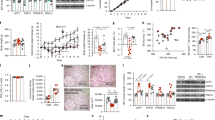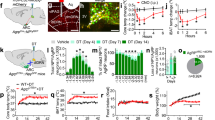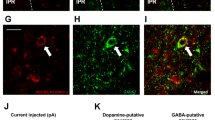Abstract
Objective:
To determine whether the anorexigenic peptide, nesfatin-1 affects energy expenditure, and to follow the time course of its effects.
Design:
Food intake duration, core body temperature, locomotor activity and heart rate of rats were measured by telemetry for 48 h after a single intracerebroventricular injection of 25 or 100 pmol nesfatin-1 applied in the dark or the light phase of the day. Body weight, food and water intake changes were measured daily. Furthermore, cold-responsive nesfatin-1/NUCB2 neurons were mapped in the brain.
Results:
Nesfatin-1 reduced duration of nocturnal food intake for 2 days independently of circadian time injected, and raised body temperature immediately, or with little delay depending on the dose and circadian time applied. The body temperature remained higher during the next light phases of the 48 h observation period, and the circadian curve of temperature flattened. After light phase application, the heart rate was elevated transiently. Locomotion did not change. Daily food and water intake, as well as body weight measurements point to a potential decrease in all parameters on the first day and some degree of compensation on the second day. Cold-activated (Fos positive) nesfatin-1/NUCB2 neurones have been revealed in several brain nuclei involved in cold adaptation. Nesfatin-1 co-localised with prepro-thyrotropin-releasing hormone in cold responsive neurones of the hypothalamic paraventricular nucleus, and in neurones of the nucleus raphe pallidus and obscurus that are premotor neurones regulating brown adipose tissue thermogenesis and skin blood flow.
Conclusion:
Nesfatin-1 has a remarkably prolonged effect on food intake and body temperature. Time course of nesfatin-1's effects may be varied depending on the time applied. Many of the nesfatin-1/NUCB2 neurones are cold sensitive, and are positioned in key centres of thermoregulation. Nesfatin-1 regulates energy expenditure a far more potent way than it was recognised before making it a preferable candidate anti-obesity drug.
This is a preview of subscription content, access via your institution
Access options
Subscribe to this journal
Receive 12 print issues and online access
$259.00 per year
only $21.58 per issue
Buy this article
- Purchase on Springer Link
- Instant access to full article PDF
Prices may be subject to local taxes which are calculated during checkout






Similar content being viewed by others
References
Oh-I S, Shimizu H, Satoh T, Okada S, Adachi S, Inoue K et al. Identification of nesfatin-1 as a satiety molecule in the hypothalamus. Nature 2006; 443: 709–712.
Maejima Y, Sedbazar U, Suyama S, Kohno D, Onaka T, Takano E et al. Nesfatin-1-regulated oxytocinergic signaling in the paraventricular nucleus causes anorexia through a leptin-independent melanocortin pathway. Cell Metab 2009; 10: 355–365.
Shimizu H, Oh IS, Okada S, Mori M . Nesfatin-1: an overview and future clinical application. Endocr J 2009; 56: 537–543.
Yosten GL, Samson WK . Nesfatin-1 exerts cardiovascular actions in brain: possible interaction with the central melanocortin system. Am J Physiol Regul Integr Comp Physiol 2009; 297: R330–R336.
Merali Z, Cayer C, Kent P, Anisman H . Nesfatin-1 increases anxiety- and fear-related behaviors in the rat. Psychopharmacology (Berl) 2008; 201: 115–123.
Konczol K, Bodnar I, Zelena D, Pinter O, Papp RS, Palkovits M et al. Nesfatin-1/NUCB2 may participate in the activation of the hypothalamic-pituitary-adrenal axis in rats. Neurochem Int 2010; 57: 189–197.
Aydin S, Dag E, Ozkan Y, Erman F, Dagli AF, Kilic N et al. Nesfatin-1 and ghrelin levels in serum and saliva of epileptic patients: hormonal changes can have a major effect on seizure disorders. Mol Cell Biochem 2009; 328: 49–56.
Kohno D, Nakata M, Maejima Y, Shimizu H, Sedbazar U, Yoshida N et al. Nesfatin-1 neurons in paraventricular and supraoptic nuclei of the rat hypothalamus coexpress oxytocin and vasopressin and are activated by refeeding. Endocrinology 2008; 149: 1295–1301.
Brailoiu GC, Dun SL, Brailoiu E, Inan S, Yang J, Chang JK et al. Nesfatin-1: distribution and interaction with a G protein-coupled receptor in the rat brain. Endocrinology 2007; 148: 5088–5094.
Fort P, Salvert D, Hanriot L, Jego S, Shimizu H, Hashimoto K et al. The satiety molecule nesfatin-1 is co-expressed with melanin concentrating hormone in tuberal hypothalamic neurons of the rat. Neuroscience 2008; 155: 174–181.
Pereira-da-Silva M, Torsoni MA, Nourani HV, Augusto VD, Souza CT, Gasparetti AL et al. Hypothalamic melanin-concentrating hormone is induced by cold exposure and participates in the control of energy expenditure in rats. Endocrinology 2003; 144: 4831–4840.
Lechan RM, Fekete C . The TRH neuron: a hypothalamic integrator of energy metabolism. Prog Brain Res 2006; 153: 209–235.
Masaki T, Yoshimichi G, Chiba S, Yasuda T, Noguchi H, Kakuma T et al. Corticotropin-releasing hormone-mediated pathway of leptin to regulate feeding, adiposity, and uncoupling protein expression in mice. Endocrinology 2003; 144: 3547–3554.
Solinas G, Summermatter S, Mainieri D, Gubler M, Montani JP, Seydoux J et al. Corticotropin-releasing hormone directly stimulates thermogenesis in skeletal muscle possibly through substrate cycling between de novo lipogenesis and lipid oxidation. Endocrinology 2006; 147: 31–38.
Fan W, Voss-Andreae A, Cao WH, Morrison SF . Regulation of thermogenesis by the central melanocortin system. Peptides 2005; 26: 1800–1813.
Kong WM, Stanley S, Gardiner J, Abbott C, Murphy K, Seth A et al. A role for arcuate cocaine and amphetamine-regulated transcript in hyperphagia, thermogenesis, and cold adaptation. FASEB J 2003; 17: 1688–1690.
Ellacott KL, Lawrence CB, Rothwell NJ, Luckman SM . PRL-releasing peptide interacts with leptin to reduce food intake and body weight. Endocrinology 2002; 143: 368–374.
Mikics E, Baranyi J, Haller J . Rats exposed to traumatic stress bury unfamiliar objects--a novel measure of hyper-vigilance in PTSD models? Physiol Behav 2008; 94: 341–348.
Toth ZE, Mezey E . Simultaneous visualization of multiple antigens with tyramide signal amplification using antibodies from the same species. J Histochem Cytochem 2007; 55: 545–554.
Johnson H, Ulfhake B, Dagerlind A, Bennett GW, Fone KC, Hokfelt T . The serotoninergic bulbospinal system and brainstem-spinal cord content of serotonin-, TRH-, and substance P-like immunoreactivity in the aged rat with special reference to the spinal cord motor nucleus. Synapse 1993; 15: 63–89.
Bratincsak A, Palkovits M . Activation of brain areas in rat following warm and cold ambient exposure. Neuroscience 2004; 127: 385–397.
Stengel A, Goebel M, Wang L, Rivier J, Kobelt P, Monnikes H et al. Central nesfatin-1 reduces dark-phase food intake and gastric emptying in rats: differential role of corticotropin-releasing factor2 receptor. Endocrinology 2009; 150: 4911–4919.
Tanida M, Mori M . Nesfatin-1 stimulates renal sympathetic nerve activity in rats. Neuroreport 2011; 22: 309–312.
Berthoud HR, Patterson LM, Sutton GM, Morrison C, Zheng H . Orexin inputs to caudal raphe neurons involved in thermal, cardiovascular, and gastrointestinal regulation. Histochem Cell Biol 2005; 123: 147–156.
Szekely M, Petervari E, Pakai E, Hummel Z, Szelenyi Z . Acute, subacute and chronic effects of central neuropeptide Y on energy balance in rats. Neuropeptides 2005; 39: 103–115.
Goebel M, Stengel A, Wang L, Tache Y . Central nesfatin-1 reduces the nocturnal food intake in mice by reducing meal size and increasing inter-meal intervals. Peptides 2011; 32: 36–43.
Ellacott KL, Lawrence CB, Pritchard LE, Luckman SM . Repeated administration of the anorectic factor prolactin-releasing peptide leads to tolerance to its effects on energy homeostasis. Am J Physiol Regul Integr Comp Physiol 2003; 285: R1005–R1010.
Buwalda B, de Boer SF, Van Kalkeren AA, Koolhaas JM . Physiological and behavioral effects of chronic intracerebroventricular infusion of corticotropin-releasing factor in the rat. Psychoneuroendocrinology 1997; 22: 297–309.
Skibicka KP, Alhadeff AL, Grill HJ . Hindbrain cocaine- and amphetamine-regulated transcript induces hypothermia mediated by GLP-1 receptors. J Neurosci 2009; 29: 6973–6981.
Cahill AL, Ehret CF . Alpha-methyl-p-tyrosine shifts circadian temperature rhythms. Am J Physiol 1982; 243: R218–R222.
Aguzzi J, Bullock NM, Tosini G . Spontaneous internal desynchronization of locomotor activity and body temperature rhythms from plasma melatonin rhythm in rats exposed to constant dim light. J Circadian Rhythms 2006; 4: 6.
Makino M, Hayashi H, Takezawa H, Hirai M, Saito H, Ebihara S . Circadian rhythms of cardiovascular functions are modulated by the baroreflex and the autonomic nervous system in the rat. Circulation 1997; 96: 1667–1674.
Foo KS, Brismar H, Broberger C . Distribution and neuropeptide coexistence of nucleobindin-2 mRNA/nesfatin-like immunoreactivity in the rat CNS. Neuroscience 2008; 156: 563–579.
Morrison SF, Nakamura K . Central neural pathways for thermoregulation. Front Biosci 2011; 16: 74–104.
Seale P, Kajimura S, Spiegelman BM . Transcriptional control of brown adipocyte development and physiological function--of mice and men. Genes Dev 2009; 23: 788–797.
Oldfield BJ, Giles ME, Watson A, Anderson C, Colvill LM, McKinley MJ . The neurochemical characterisation of hypothalamic pathways projecting polysynaptically to brown adipose tissue in the rat. Neuroscience 2002; 110: 515–526.
Cano G, Passerin AM, Schiltz JC, Card JP, Morrison SF, Sved AF . Anatomical substrates for the central control of sympathetic outflow to interscapular adipose tissue during cold exposure. J Comp Neurol 2003; 460: 303–326.
Verty AN, Allen AM, Oldfield BJ . The endogenous actions of hypothalamic peptides on brown adipose tissue thermogenesis in the rat. Endocrinology 2010; 151: 4236–4246.
Garcia-Galiano D, Navarro VM, Roa J, Ruiz-Pino F, Sanchez-Garrido MA, Pineda R et al. The anorexigenic neuropeptide, nesfatin-1, is indispensable for normal puberty onset in the female rat. J Neurosci 2010; 30: 7783–7792.
Tan BK, Hallschmid M, Kern W, Lehnert H, Randeva HS . Decreased cerebrospinal fluid/plasma ratio of the novel satiety molecule, nesfatin-1/NUCB-2, in obese humans: evidence of nesfatin-1/NUCB-2 resistance and implications for obesity treatment. J Clin Endocrinol Metab 2011; 96: E669–E673.
Acknowledgements
We would like to thank Éva Rédei (Northwestern University, Chicago, IL, USA) for kindly providing the prepro-TRH antibody and for Szilvia Deák and Judit Kerti for the technical assistance. The study was sponsored by ETT—2009/ 495 (ZE Toth) and by OTKA CK-80180 (M Palkovits, ZE Toth, K Könczöl) and OTKA NK-71629 (D Zelena) and TÁMOP-4.2.1.B-09/1/KMR-2010-0001. ZE Toth is supported by the Bolyai fellowship.
Author information
Authors and Affiliations
Corresponding authors
Ethics declarations
Competing interests
The authors declare no conflict of interest.
Additional information
Supplementary Information accompanies the paper on International Journal of Obesity website
Rights and permissions
About this article
Cite this article
Könczöl, K., Pintér, O., Ferenczi, S. et al. Nesfatin-1 exerts long-term effect on food intake and body temperature. Int J Obes 36, 1514–1521 (2012). https://doi.org/10.1038/ijo.2012.2
Received:
Revised:
Accepted:
Published:
Issue Date:
DOI: https://doi.org/10.1038/ijo.2012.2
Keywords
This article is cited by
-
NUCB-2/Nesfatin-1 promotes the proliferation of nasopharyngeal carcinoma cells
Cancer Cell International (2023)
-
NUCB2/Nesfatin-1 drives breast cancer metastasis through the up-regulation of cholesterol synthesis via the mTORC1 pathway
Journal of Translational Medicine (2023)
-
NUCB2: roles in physiology and pathology
Journal of Physiology and Biochemistry (2022)
-
Reward-representing D1-type neurons in the medial shell of the accumbens nucleus regulate palatable food intake
International Journal of Obesity (2019)
-
Scans for signatures of selection in Russian cattle breed genomes reveal new candidate genes for environmental adaptation and acclimation
Scientific Reports (2018)



